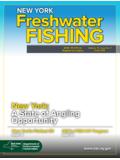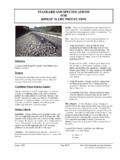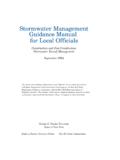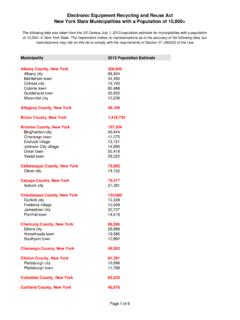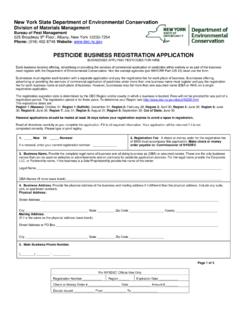Transcription of Trapping in the 21st Century, 2010 edition
1 36 Trapping in the 21st century Copyright 1998. Updated in 2010 in response to new regulations. All rights reserved. Material may not be reproduced in any manner without express written permission from the New York State Trapper's Association. Specific products are mentioned for information only and does not imply endorsement by the author, the New York State Trapper's Association or the New York State Department of Environmental Conservation. Criticism is not implied of products not mentioned. The use of these selective Trapping techniques in New York State is supported by the following groups: The New York State Trappers Association & its affiliates NYS Department of Environmental Conservation New York Houndsmen Conservation Association Inc.
2 Three Rivers Coon Hunters Association American Wildlife Research Foundation New York River Otter Project, Inc. Camp Fire Club of America New York Farm Bureau New York State Conservation Council Conservation Fund Advisory Board Fish & Wildlife Service New York Chapter of The Wildlife Society The National Trappers Association New York State Fish & Wildlife Management Board New York State Conservation Officers Association Trapping in the 21st century 2010 updated edition 2 Trapping in the 21st century Dear Reader: Trappers in New York have a long and proud heritage.
3 After all, New York State was explored and settled largely due to the fur trade. New York State has an abundance of furbearing animals whose populations are thriving and secure. For nearly ten-thousand New Yorkers, Trapping remains a vitally important activity, affecting both their life style and livelihood. People trap for many reasons, including enjoyment of the outdoors, supplementing personal income, controlling nuisance wildlife, and contributing to New York's wildlife management program. Trappers must be trained and certified via New York's Trapper Education Program and they are subject to dozens of laws and regulations affecting how, when, and where traps are set.
4 The future of Trapping , however, is not assured. The future rests with the actions of today's (and tomorrow's) trappers. This booklet has been produced to help the modern trapper learn and use methods that are responsible, ethical, and humane. The New York State Trappers Association and the New York State Department of Environmental Conservation strongly believe that trappers must use state-of-the-art Trapping techniques meeting this high standard. Some people believe that Trapping is irresponsible and cruel. When Trappers use the best methods available, however, as described in this publication, they are being responsible and humane. Because public perceptions play such an important role in the future of an activity like Trapping , each person who sets a trap is helping to determine whether Trapping will continue.
5 Trappers should read this book carefully and use the techniques described. Be responsible because your future as a trapper will be determined by your actions. --Gerald Leggieri Past President New York State Trappers Association. --Gerald A. Barnhart - Retired Director, New York State Division of Fish, Wildlife and Marine Resources Trapping in the 21st century 35 Acknowledgments: This booklet was compiled by Angie Berchielli. This text is based upon the experience of numerous trappers and biologists to whom the author is greatly indebted. The Wisconsin Trappers Association and the Wisconsin Department of Natural Resources have taken the lead in recommending selective Trapping methods for bodygripping traps on land.
6 Rick Tischaefer was especially helpful. The author would like to thank Gerry Barnhart, Gordon Batcheller, Andrew MacDuff, Lou Berchielli, Mark Brown, Bob Gotie, Marie Kautz, Drusila Pagan, and Scott Smith of NYSDEC and Tracy Gingrich, Diane Mann-Klager, Sherry Morgan, Paul O Neil, John Organ and David Stilwell of the Fish & Wildlife Service for their technical review and comments. The author would also like to thank Robert Budliger of the NYSDEC, Director of Environmental Education (retired), and Dennis Money of the New York River Otter Project, Inc. The author would like to thank all the NYSTA trappers, especially Henry Buell, Doug Lansburg, Gerry Leggieri, John Rockwood, Wayne Jones, Dave Miller, Pete Smith and Al West.
7 Drawings were by Mike Stickney of NYS-DEC (retired) with permission from NYSDEC and photographs were by the author. 34 Trapping in the 21st century Notes Introduction Now that we are in the 21st century , trappers should reflect on our past. Many thought the Trapping tradition and life style would never last this long. But Trapping today is still very viable. We need to be dynamic and adaptable, just as the earliest trappers were. But more than anything else, we all need to think carefully about what we are doing and use common sense. We must be aware of the possible consequences and conflicts that may result from our actions. Learning From Our Heritage History shows us that Trapping has always been dynamic.
8 The history of Trapping and New York's role in that history is long and colorful. Trapping in North America started centuries ago with Native Americans using snares, pit traps and deadfalls. Europeans brought new devices made of metal. Around 1500, North American fur was being sent to Europe. The "Beaver Era" started by 1550 and lasted for about 300 years. Dutch traders built two key outposts on the Hudson River. Fort Orange (present day Albany) was built in 1624 and in 1626, New Amster-dam was established in a place the Native Americans called Menahanwi (now Manhattan). The Hudson Bay Company, the oldest commercial enterprise in North America, was granted its charter in 1670.
9 During the 1700s, there were fierce rivalries between the French and the English for control of the fur trade. In 1808 the leading fur dealer in America, John Jacob Astor, obtained his Charter for the American Fur Co. from New York. In 1821, the first attempts at conservation of beaver were put in place by George Trapping in the 21st century 3 4 Trapping in the 21st century Simpson who was in charge of Hudson Bay Company of North America. He established open and closed seasons for beaver, placing a ban on kits and summer beaver and attempted to redirect harvest pressure. This is the basic premise of season setting that we are familiar with today. Between 1825-1840 "the rendezvous system" became the method of collecting fur from trappers in the West.
10 It was adopted by William Ashley as a cost cutting alternative to building new outposts. Our current fur auctions and conventions came from this idea. Around 1830 the price of beaver fell because of competition from silk hat manufacturers, and by 1840 the "Beaver Era" was over. Increased human populations and land settle-ment caused many wildlife populations to decline, including many furbearers such as beaver, otter, fisher and marten. Wildlife was no longer highly valued. Most furbearers were actually considered vermin. As late as 1918, the then Conservation Commission in New York State had equipped all game protectors with 25-20 caliber Winchester carbines " to be used for killing of vermin.
